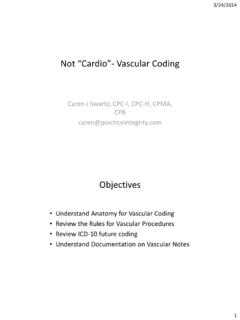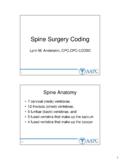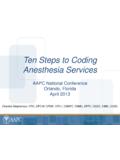Transcription of Interventional Cardiovascular Coding: Peripherals - …
1 3/1/201111 Interventional Cardiovascular coding : PeripheralsAngioplastyAtherectomyStent Placement2 peripheral Interventions Agenda Lower Extremity Endovascular Revascularization Non-Lower Extremity Angioplasty, Atherectomy and Stent Placement3/1/201123 Lower Extremity Endovascular Revascularization CPT codes 37220-37235 describe the use of endovascular techniques for lower extremity revascularization The endovascular techniques described by these codes include angioplasty, atherectomy and stent placement Angioplasty is included in all these codes The procedures may be performed using percutaneous and/or open techniques The clinical indication is treatment of occlusive vascular disease Separately reportable procedures include thrombolysis (37201, 75896), thrombectomy (37184, 37185, 37186)
2 And embolization procedures (37204, 75894, 75898)4 Lower Extremity Endovascular Revascularization Angioplasty utilizes a balloon to dilate a hemodynamically significant vessel stenosis. This includes use of a compliant or non-compliant balloon, a cryoplasty balloon or a cutting balloon Atherectomy is performed utilizing photoablation (laser), rotational (Rotoblater, Diamondback Orbital) or directional cutting (Silver Hawk) devices Stent placement utilizes bare metal, drug-eluting, balloon-expandable, self-expanding or covered stents to effectively treat a stenosis3/1/201135 Lower Extremity Endovascular Revascularization These codes are specific for 3 distinct lower extremity vascular territories: the iliac, femoral/poplitealand tibial/peroneal There are 3 separately billable arteries in the iliac territory: the common, external and internal iliac arteries There is only 1 separately billable artery in the femoral/poplitealterritory.
3 This includes the common femoral, superficial femoral, profundafemoral and poplitealarteries treated as a single vessel for coding purposes There are 3 separately billable arteries below the knee: the peroneal, anterior tibial(which includes the dorsalispedisartery) and the posterior tibial(which includes the medial malleolarartery). The tibial/peronealtrunk is considered part of a peronealand/or posterior tibialdistal Extremity Arterial AnatomyRight Transfemoral ApproachFirst orderSecond orderThird orderNon-selectiveAntegrade Right Femoral ApproachRetrograde Right Femoral Approach3/1/201147 Lower Extremity Endovascular Revascularization Codes 37220-37235 are applicable to both open or percutaneousapproach and include closure of the open or percutaneousaccess site with stitches, pressure, or device placement (do not bill G0269)
4 These codes include conscious sedation, vascular access, all catheter placements in the same vascular family the intervention is performed in, and work involved with crossing the lesion (including use of specialty guidewires, subintimalrecanalization, radiofrequency or ultrasonic vibration wires/catheters, etc.) They also include imaging related to the entire procedure (no S&I code), use of an embolic protection device, angioplasty (if done), and closure device angiography Atherectomybundling for codes 37220-37235 only applies to infra-inguinal arteries. Use Category III code 0238T forseparate supra-inguinal iliac artery atherectomy8 Lower Extremity Endovascular Revascularization Diagnostic angiography IS separately coded at the time of these interventions if: There has not been a prior catheter based angiogram and a complete study is performed and the decision for intervention is based on this angiographic study There is a prior study, but There is change in clinical status since prior study The prior study was inadequate for visualization of the area of concern There is change in the clinical status during the intervention that requires imaging outside the area treated Diagnostic angiography IS NOT separately coded at the time of these interventions if.
5 The angiography is included in the Interventional procedural code description Performed for vessel measurement and sizing, lesion localization, roadmapping, and consists of contrast injections and imaging relating to guidance necessary to perform the intervention Follow-up after angioplasty, atherectomy, stent placement, thrombectomy, Extremity Endovascular Revascularization Code 1 intervention per vessel treated (the entire femoral/popliteal territory is considered a single vessel) Code the highest level of intervention in that territory as the initial intervention. Other vessel interventions in the same territory are coded with additional Interventional codes. (The femoral/popliteal territory does not have initial as it is only one vessel) All interventions within a single vessel are always coded with a single Interventional code (except iliac atherectomy) Code each territory separately.
6 Use the initial code for the highest level intervention in each iliac and tibial/peroneal territory. These are unilateral codes Use 59 to modify interventions in the same territory but in the opposite leg. Modifier 50 may be appropriate. Discuss with your payer10 Lower Extremity Endovascular Revascularization Codes 37220-37235 describe either angioplasty alone, atherectomy w or w/o angioplasty, stent placement w or w/o angioplasty and stent placement and atherectomy w of w/o angioplasty The femoral/popliteal and tibial/peroneal territory codes incorporate atherectomy procedures. The iliac territory does not The iliac territory codes only describe angioplasty and stent placement w or w/o angioplasty. Iliac atherectomy is additionally coded per vessel treated with Category III code 0238T3/1/2011611 Lower Extremity Endovascular Revascularization A maximum of 1 initial and 2 additional interventions can be performed in a unilateral iliac system, 1 intervention in the femoral/poplitealsystem, and 1 initial and 2 additional interventions in the tibial/peronealsystem Bridging lesions are coded as a single vessel intervention, even if the lesion is bridging into another arterial territory The coding is built on an increasing hierarchy of complex interventions performed.
7 Stent placement with atherectomysupersedes stent placement or atherectomyalone, which supersedes angioplasty alone. Atherectomysupercedesstent placement in the tibial/peronealvessels. All interventions include an angioplasty if done There are 4 iliac, 4 femoral/poplitealand 8 tibial/peronealartery endovascular revascularization codes 12 Iliac Artery Endovascular Revascularization 37220 Iliac angioplasty, initial vessel 37221 Iliac stent, initial vessel 37222 Iliac angioplasty, additional vessel 37223 Iliac stent, additional vessel 0238T Iliac atherectomy, each vessel, (bill separately) Use 1 initial vessel and up to 2 additional vessel interventions if done. Use 59 modifier for an initial intervention in the contralateral iliac arteries3/1/2011713 Femoral/Popliteal Endovascular Revascularization 37224 Fem/pop system angioplasty 37225 Fem/pop system atherectomy 37226 Fem/pop system stent placement 37227 Fem/pop system stent placement withatherectomy Only submit 1 of the above codes per extremity.
8 Use 59 modifier for an intervention in the contralateral femoral/popliteal arteries14 Tibial/Peroneal Artery Endovascular Revascularization 37228 Tibial/peroneal angioplasty, initial vessel 37229 Tibial/peroneal atherectomy, initial vessel 37230 Tibial/peroneal stent placement, initial vessel 37231 Tibial/peroneal stent placement withatherectomy Only submit 1 of the above codes per extremity. Use 59 modifier for an initial intervention in the contralateral tibial/peroneal arteries3/1/2011815 Tibial/Peroneal Artery Endovascular Revascularization 37232 Tibial/peroneal angioplasty, each add. vessel 37233 Tibial/peroneal atherectomy, each add. vessel 37234 Tibial/peroneal stent placement, each add. vessel 37235 Tibial/peroneal stent placement andatherectomy, each additional vessel List up to 2 additional codes separately in addition to the initial vessel code per extremity.
9 Use 59 modifier for an initial intervention in the contralateral tibial/peroneal arteries16 Case #1 Patient with left leg pain. Via right femoral approach, selective complete bilateral lower extremity run-off is performed with catheter placement in the left common iliac and via sheath. A 90% stenosis of left common and a separate 80% left external iliac stenosis is present. The SFA shows 70-80% diffuse disease with a separate short segment occlusion of the popliteal artery. The tibial/peroneal arteries are widely patent. Angioplasty is performed in the common and external iliac, SFA and popliteal arteries with stent placement required in the popliteal for 80% residual stenosis after the angioplasty Extremity Arterial AnatomyRight Transfemoral ApproachFirst orderSecond orderThird orderNon-selectiveAntegrade Right Femoral ApproachRetrograde Right Femoral Approach18 Case #1 Answer 75716-59 -Bilateral lower extremity diagnostic angiography 37220 Common iliac angioplasty, initial vessel 37222 External iliac angioplasty, additional vessel 37226 Femoral/popliteal stent placement (includes angioplasty)3/1/20111019 Case #2 Via right femoral approach, catheter placement into the contralateral left common femoral artery with left leg run-off, with right leg runoff via the sheath.
10 New left antegrade CFA puncture with left SFA angioplasty of a 5 cm occlusion. This required a covered stent placement due to 70% residual stenosis. Laser atherectomy is performed in the mid popliteal artery. Post laser angioplasty was necessary. The tibial/peroneal-trunk, mid posterior tibial, and medial malleolar arteries had stenoses and occlusions treated with laser atherectomy. The mid and distal anterior tibial, along with the dorsalis pedis arteries were also treated with laser for similar disease. Adjunctive angioplasty is performed in all 5 vessels after the atherectomy. Stent placement is necessary in the tibial/peroneal trunk for flow-limiting Extremity Arterial AnatomyRight Transfemoral ApproachFirst orderSecond orderThird orderNon-selectiveAntegrade Right Femoral ApproachRetrograde Right Femoral Approach3/1/20111121 Case #2 Answer 75716-59 Bilateral lower extremity angiography, S&I 36246-59 Contralateral left CFA catheter placement 37227 SFA stent and popliteal atherectomy with angioplasty 37231 Posterior tibial atherectomy with TP trunk stent 37233 Anterior tibial atherectomy, includes angioplasty Medial malleolar intervention is part of the posterior tibial, and the dorsalis pedis intervention is part of the anterior tibial artery intervention22 Case #3 Patient with known 10 cm SFA occlusion.















